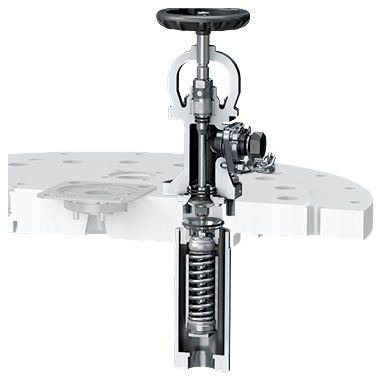When it comes to reducing the risk of railcar hazardous product releases, it’s good to remember that two valves are better than one.
Recognizing this, Midland Manufacturing, Inc. has combined its A-719-ML model Top-Transfer Angle Valve and A-190 Check Valve to create the A-719-ML/A-190 Dual Valve System, which provides additional defense against leaks of toxic inhalation hazard (TIH) commodities, such as chlorine, anhydrous ammonia and ethylene oxide.

When paired together, the A-719-ML/A-190 Dual Valve System helps to provide protection against the release of railcar contents in the event of a roll-over accident. Should a railcar roll-over accident occur, the angle valve is designed to shear off, and the check valve becomes the primary seal, halting product flow.
The Dual Valve System is also easy to install, with the check valve fitted through the top of the cover plate, allowing it to be serviced or replaced without removing the cover plate or cutting the valve. The Dual Valve System can be installed on 18-inch or larger cover plates.
The A-719-ML Angle Valve features adjustable spring-loaded packing and a three-bolt Monel® outlet flange, along with a Monel bonnet and valve body. The valve stem and body insert are both constructed of Hastelloy™ C, with the O-ring and seal fashioned from Viton® and PTFE, respectively. The elevated seat design of the valve permits self-draining, designed to help prevent accidental release or product entrapment. The spring-loaded valve stem packing provides constant load on the packing rings, which when combined with replaceable threaded side and top ports, enables quick in-service maintenance and repair with no need to remove the valve.
The A-190 Check Valve provides reliable, high flow rates with high sensitivity to flow disturbance, a combination that helps enable safer operation and faster unloading times when handling hazardous materials. Like the A-719-ML, the A-190 has a Hastelloy C body and stem, along with a Viton O-ring and PTFE seal, with the spring constructed of Inconel®. All of these components are non-galling, and Midland’s exclusive solid steel retaining bar prevents the ball from dropping out of the bottom of the valve. And should the valve “check,” a pressure bypass enables rapid reopening to reset it.
The combined capabilities of the A-719-ML/A-190 Dual Valve System have allowed it to meet the guidelines of the Chlorine Institute’s Pamphlet 68, which governs the use of “Dual Valve Systems for Bulk Chlorine Transport.” Specifically, Pamphlet 68 spells out performance and selection criteria that should be utilized when identifying and deploying dual valve systems that can be used in bulk chlorine transport. These criteria are in line with the performance standards set forth by the U.S. Department of Transportation and Transport Canada.